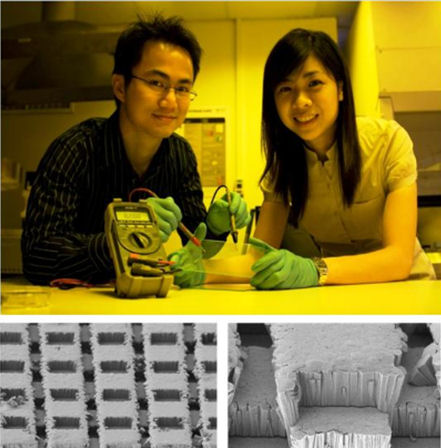
“Scientists from the National University of Singapore (NUS), one of the world’s leading university, have demonstrated that it is possible to replace ITO in dye sensitized solar cell (DSSC) with 3-dimensional transparent conductors (TC) fabricated using a cheap aqueous method. Dr Ho Ghim Wei and her team successfully fabricated Ga : ZnO films directly on glass substrates via a low-temperature aqueous route for application in dye-sensitized solar cells. Preliminary electrical and optical characterization of the films showed that 85% transparency across the optical range with sheet resistances as low as 15 Ωsq−1 were achievable, making them comparable to commercial transparent conducting oxides. Novel non-planar transparent conducting electrodes consisting of pillars, cross-hatched trenches and pit structures were fabricated to produce films with increased surface roughness and superior light scattering capabilities which are essential for photovoltaic applications. The work concludes with proof of concepts demonstrating the feasibility of large-scale fabrication and the compatibility of the electrodes for dye-sensitized solar cells. This significant achievement can allow various electronics manufacturers to use the newly-designed electrodes to make the same device at a lower cost and higher efficiency (50-70%). This will greatly enhance the attractiveness of such unique electrodes in various electronics consumer market.
“ITO is expensive so we decided to develop solution processable electrodes consisting of architectured 3D structures with tunable optical and electrical properties” said Dr Ho Ghim Wei, the Principal investigator and Assistant Professor at the Electrical and Computer Engineering Department at NUS. “The TCs are designed to effectively scatter light and transport photogenerated electrons through homojunction electrodes which enhance electrical performance” said Kevin Moe, a graduate student working on this project.
Current electronic devices uses ITO as the electrode fabricated using vacuum process, which is not cost-effective. By employing an aqueous route, it is possible to make large area TC for DSCC and other devices.
Their research paper entitled “Non-Planar Geometries of Solution Processable Transparent Conducting Oxide: From Film Characterization to Architectured Electrodes ”was published in the Energy and Environmental Science journal (DOI: 10.1039/C2EE21296J) earlier this year. The scientists have since shown efficiencies that have exceeded the published results. The NUS scientists are also exploiting the developed materials for new applications that will benefit from the low cost and scalable process.”
REGI [Read More]